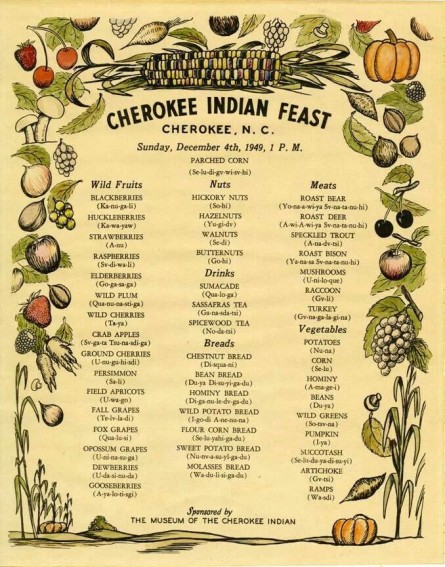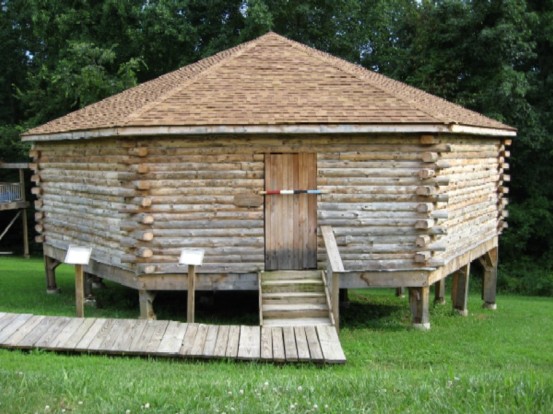Cherokee Food and Agriculture

Cherokee Indian Feast https://s-media-cache-ak0.pinimg.com/originals/d6/9d/f2/d69df22511b64bd514dd2b409d389506.jpg
Taken from a manuscript prepared by J.P. Evans in 1835.
“Hospitality is a prominent feature in Cherokee character and that instinctive impulse to “eat when you are hungry” is scrupulously complied with by them when among their own people and anything can be found acceptable to a hungry stomach. To such a height is this custom carried, that in many towns an invitation is not a necessary preliminary to eating; whether the person be a stranger or a relative; and from a native, no compensation is required for eating, lodging, and provender for beasts.”
When the Spanish encountered the Cherokee Indians in 1540, each Cherokee village provided:”700 turkeys, 20 baskets of mulberries and 300 hairless dogs (actually opossums).”The Cherokee have relied on fishing and hunting deer, bear, wild turkeys, and small game. They had a varied diet and the women farmed the land growing mostly: corn (maize), beans, squash, melons, sweet potatoes and sunflowers. The Cherokee had systems of irrigation and rotated their crops in order to keep the ground fertile and produce mass quantities of foods in excess so they could survive the winters.
They utilized the “Three Sister’s Gardening Method” interplanting corn, beans and squash in the same mounds of soil.

Three Sister’s Gardening Method. source: http://cherokeeofsouthcarolina.com/projects-HealthandDiet.html
The complimentary foods, corn, beans and squash rely on each other in this system to grow and yield the most food. The beans use the corn stalks to climb on, which stabilizes and strengthens the corn plant.
Beans gather nitrogen on their roots which promotes nitrogen and fortifies the earth for subsequent crops. The shallow squash rooting system provides a type of mulch for the plants and prevents moisture evaporation.
Kanuchi

Hickory Nut.
source: http://www.manataka.org/page1103.htm
There are many dishes that originated from the Cherokee Indians that we enjoy today such as: bread pudding, blackberry cobbler, beans and cornbread, potato soup, and the delicacy Kanuchi.The hickory nut was a food staple of Cherokee Indians their entire existence. The nut is used in many recipes and grew prolifically in the regions the Cherokee people lived.

Cherokee woman making Kanuchi. source:http://cherokeeregistry.com/index.php?option=com_content&view=article&id=186&Itemid=256
(Above) A Cherokee woman is pounding hickory nuts into the large hollowed out log. Heavy labor is involved in the entire process for this nutrient rich delicacy among the tribe.
Shelter
The Cherokee people had several styles of homes none of which include the famous teepee style that the Plains Indians utilize. The Cherokee homes were built by the early inhabitants were circular huts. Using river reeds, they bent the branches in a circle to form a peak in the middle. They then used mud and plant material to secure the walls and thatched roofs insulated well for the winter.
Thatched roof dome hut
Source: http://1.bp.blogspot.com/-tDCRpQHILbc/TfO9WkfeO0I/AAAAAAAAAFU/Dh4XmkjzHTI/s1600/0611111216a.jpgHomes were multi-family dwellings and therefore necessary to be large in size. Many Cherokee had summer homes that were built in a square or rectangular shape. They framed the house using large poles and the outside was made with bark or wood and “wattle and daub” or woven cloth and mud. They were considerably more open often having covered patios which were ideal for summer heat.
Cherokee Log Home, North Carolina 1800’s. source: http://thomaslegion.net/cherokeeindianheritageandhistoryanintroductiontocherokeehistoryandculture.html
During the 1800’s, the Cherokee fashioned their homes as log homes after the European settlers. Many times they also used wooden planks that are still both modern methods of housing. They included a “smoke hole” in the center of the roof.
Council House
Seven sided Council House
source:https://s-media-cache-ak0.pinimg.com/originals/c8/40/5d/c8405d07dee8e95536aad0a92639fb86.jpgIn addition to the private family homes, they Cherokee Indians also built a “Town House” or “Council House” in the center of the town or village for all to gather for meetings. These houses were substantial in size in order to accommodate many people comfortably. They often consisted of seven walls as the Cherokee honored the numbers 7 and 4 as sacred and to seat the 7 different clans.


